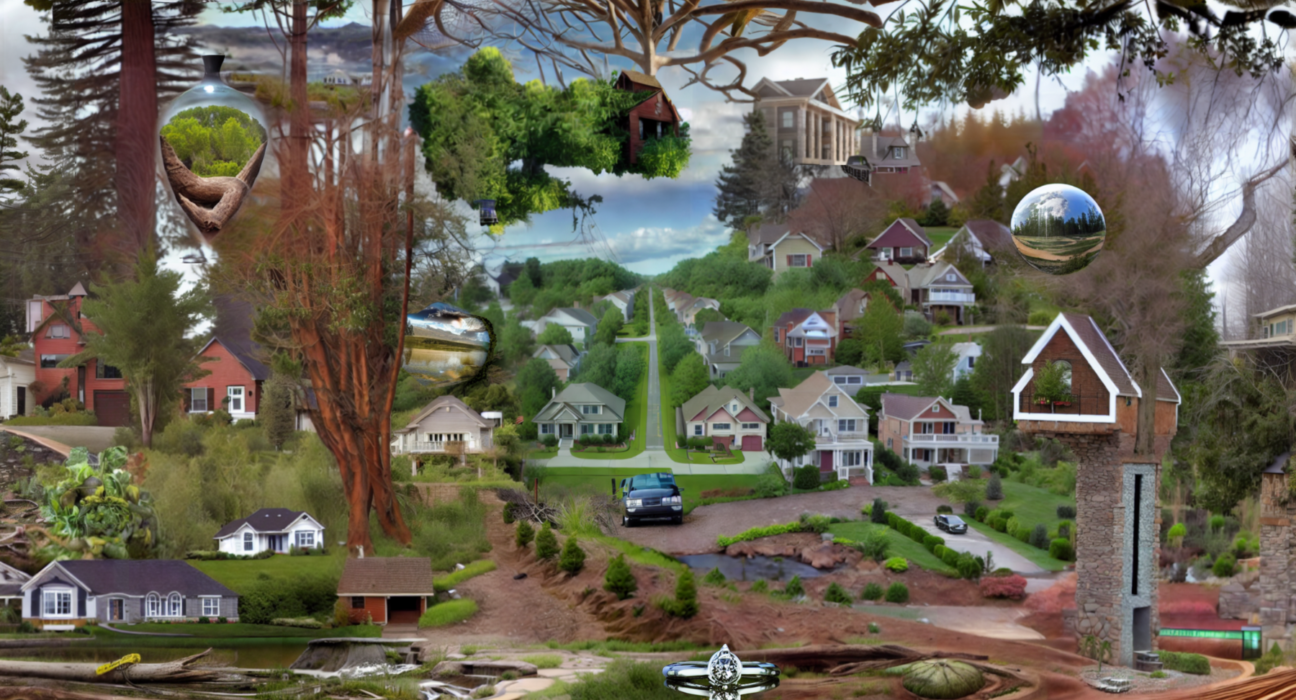Mention artificial intelligence to most artists at your own peril. Writers will bemoan the future of their craft, photographers will offer you a screed about copyright, painters will obsessively describe the importance of process and brushstroke. But some artists are exploring the potential of these new tools. During Art Basel Miami Beach, a modern and contemporary art show, last month, artist Laurie Simmons exhibited a new body of work that she made with the platforms DALL-E and Stable Diffusion.
“I couldn’t dream up how much it would benefit me and my work,” says Simmons of AI in an interview with painter and critic Walter Robinson who has also started using these tools to create art.
In Dallas, artists Melanie Clemmons and Zak Loyd have also begun using AI platforms in their practices, including their new exhibit, “Trophy Club Nissan,” which opens at Liliana Bloch Gallery this weekend. For the exhibit, the two created a body of work that draws inspiration from the local aftermath of 2021’s January 6 insurrection and explores themes Loyd calls “suburban paranoid fantasy.” And although they openly describe artificial intelligence as a collaborator, it is also their subject.
“We started plugging in very basic prompts about North Texas to see the way AI views us,” Loyd says. “A lot of doomsday prepper or conspiratorial things were showing up when we attempted to use AI as a mirror.”
“Trophy Club Nissan” draws its name from the DFW suburb and the car dealership jingle that was ubiquitous on North Texas television in the ’80s and ’90s. (Reddit dug up the original commercial, which is worth a view.) The exhibit itself is a combination of prints, video art, and various sculptural objects. There will be items recognizable to the viewer, including a rifle, a deer shoulder mount, and indoor fountains, but they all contain layers of concept and maybe even a glitch or two.
Throughout their careers, both Clemmons and Loyd have been producing work that evolves with new technologies. Clemmons is a photographer by training who teaches digital and hybrid media at Southern Methodist University; Loyd is a visual arts technician at the University of North Texas, where he teaches new media art. The pair has made art individually and together throughout the past two decades, as the internet has undergone swift, complex changes.
In the past year, most conversations about these new technologies are centered around generative AI, which creates text, images, and video often riddled with glitches that create a sort of uncanny valley effect for viewers. (Just Google “AI hands.”) These are interesting, says Loyd, who posits they’ll likely become artifacts that offer future viewers a timestamp of the technology’s early years.
As artists, Lloyd and Clemmons are just as interested in the AI that is invisible. Clemmons says much of this exhibit draws inspiration from what she describes as “the aesthetics of algorithmic filter bubbles.” Think of this as the way the echo chambers we build on the internet change how we think and eventually how we dress or behave. Current examples range from “Instagram face“, which has increased the demand for plastic surgery; to conspiracy theory rabbit holes, which have impacted national and international politics.
Clemmons is interested in the offline effects of building these online communities. More specifically for this exhibit, she and Loyd are interested in the real world violence of the 2021 attack on the U.S. Capitol, which started as an online movement. Clemmons says the earliest ideas for this body of work came when they learned how many North Texans were involved. They saw a clear line from the paranoia of the QAnon conspiracy movement to the suspicion about artificial intelligence tools.
“A lot of the paranoia we’re projecting onto AI is paranoia that we should’ve projected onto current systems and paradigms that we’re living in,” Loyd says.
The mood of the Liliana Bloch Gallery show is in some ways sinister—this is not a show that is going to make you feel better about AI. But for these artists, new technologies are not something to be afraid of. Clemmons says she doubts AI has any interest in taking over the world.
“There is a really specific part of the show that points out that before we get even close to that we’re going to have to deal with these really scary ways AI is going to present itself in our normal life,” Clemmons says. “There are these everyday ways people can use AI to misinform or draw terror.”
“We’re not scared of AI as the entity, we’re more scared of humans using AI,” Loyd says.
“Trophy Club Nissan” opens with a reception from 4–7 p.m. Saturday, January 6, and remains on display at Liliana Bloch Gallery through February 17. There will be an artist talk at 3 p.m. January 6. For information and hours visit lilianablochgallery.com.
Author


